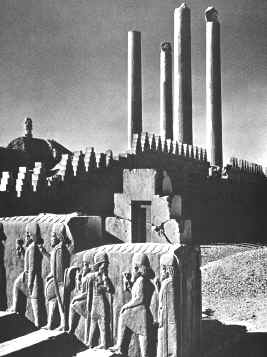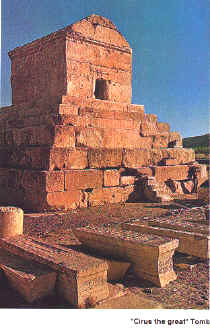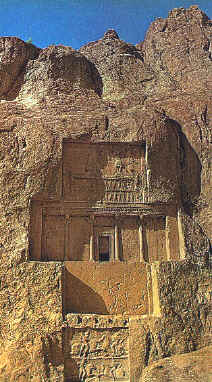Architecture
"The meaningful Impact of Persian architecture Is versatile. New overwhelming and
dignified, magnificent and impressive, charmingly fairy. like."; A.U. Pope
Persian architecture can be considered through the age-old history of the land. It goes
back to the late 6th and early 5th millennia BC Persian architecture has been a
comprehensive embodiment of Iranian psychology and characteristics in different historical
periods. In studying Persian architecture four distinc, protracted, but
continuous periods are distinguished, as follows:
- Persian prehistoric architecture till the formation of the first national governmet by the Medes.
- Persian architecture from the Medes period till the end of Sassanians.
- Islamic period architecture till the end of Safavi period.
- Contemporary and present-day Persian architecture.
In connection with the present review of Persian architecture, the reader is reminded of a varying range of other arts applied by the inhabitants of Iran to decorate their different constructions. In short, such arts are: stone carving, stucco carving and plaster work, painting, tile work, brick work, mirror glasswork, honey comb work, mosaic work, and several other ornamental arts.
On the other hand, one has to consider the exceptional multiformity of buildings in terms of design and application. This diversity has arisen as a result of particular requirements and the rich tastes of Iranian artists through different periods of history.
Iranian artists have proved capable of greeting a wide range of monuments in various branches of architecture, thus providing the world with their unique artistic talents.

It seems rather difficult to classify Iranian architectural works from the earliest periods till the present day. But, the following arrangement might give a vista of such works: prehistoric huts, early villages and towns, fortresses and fortifications, temples and fire temples, mausoleums, massive ancient palaces, dams and bridges, bazaars, baths, roads, magnificent mosques, towers and minarets, religious buildings and sites from the Islamic period, as well as other monuments scattered all over Iran. Other significant aspects with deep influences on Iranian architecture were the vastness of Iranian plateau with differing climates, climatic conditions, and characteristics of people who had been scattered in various sites. As an example, the architectural styles at highlands and mountainous areas are different from those at coastal and desert areas. Now based on such an endless and marvelous versatility which may not be encountered in most countries, here we will have a transient look at Persian architecture to give a simple sketch of it. Despite its simplicity, the sketch too, would be a rich reflection of the unique aspects of Persian architecture.
A discussion of ancient Persian architecture will be impossible without making use of archaeological findings and referring to the comments given by the corresponding experts.
One of the oldest monuments discovered in the Iranian plateau is the painted building of Zaghe Tepe in Qazvin plain. Its history goes back to the late 7th and early 6th millennia BC Considering the availability of materials in prehistoric period, the painted building of Zaghe Tepe has been ornamented and decorated as far as possible. The building was intended and used for a sort of social gathering and holding of meetings. A great number of platforms and gardenias were provided for those attending the gatherings and meetings. A feature of the building is its fireplace used to heat the interior in cold season, plus a brazier used to roast skewed meat (kabob). This ancient building was provided with two depositories to keep the tools and equipment, and a smaller chamber as a living room. Walls are painted and decorated with images of wild goat. Most probably, the painted building of Zaghe Tepe had the function of a temple, religious place, and gathering center of the ne6lithic tribes in Iran.
Tepe Sialk, an important Tell near Kashan, represents another prehistoric site in Iran, whose inhabitants were the initiators of a simple and rudimentary housing technique. In its 5 phases of excavation, remains of buildings were unearthed the oldest of which belongs to the late 6th and early 5th millennia BC.
At the beginning of his settlement an Sialk, man didn't know how to build a house yet, and used to live under huts made of tree branches. Soon, building began with handmade mud brick on the remains of previous settlements.
During the 4th millennia BC, Sialk settlements became more spacious and given doors the installation openings of which are clearly visible. These buildings were made of lumps of earth and mud brick. The rudimentary handmade mud bricks were oval in the shape and dried in the sun. The architectural decoration saw the walls of rooms painted red. Doors were small and narrow, their heights not exceeding 80-90 cm.
Tepe Hassan near Damghan, Tell-i-lblis within a 72-km distance from Kerman, and Tepe Hasanlu in West Azarbaijan, are among other prehistoric sites of Iran in which architectural monuments of various periods have been excavated and unearthed.
In excavations of Tepe Hasanlu, three massive buildings were discovered, which had been built on similar plans. Their history dates back from 800 BC to 1000 BC The buildings had been provided with entrance gates, paved courtyards, rooms, nooks, and smaller store rooms. In l-lasanlu architecture, buildings seem to have been wooden (for the first time), square, tower-like structures, with columns which may have been tree trunks and erected on uncut plinths. One room was found to be paved with mud bricks. The interesting point is that another room had been used as kitchen, with a row of platforms and fireplace around it.
One of the most significant 13th century BC architectural works of Iran is the Choga Zanbil Temple (1250 BC) located in 45 km from Susa, an ancient Iranian town on the bank of Karkheh river Province of Khuzestan, southwest Iran. It was built by Huntash Huban the Elamite king on the ruins of ancient Elamite city of Dur-Untash.
The temple represents a splendid symbol of a highly developed architecture. The building is square in shape and consists of five stories, each of which is smaller than the one below it giving a conic appearance to the building. The main temple is constructed on the last floor. Construction materials of the temple are mainly glazed kiln-fired bricks of high quality bound together with a very strong mortar (containing natural bitumen). The mud brick is used between walls and plates.
The western vaults of Choga Zanbil Temple were so skillfully built that at present, even after three thousand years, they are remaining in marvelously good conditions. The vaults are constructed on prolonged corridors and over internal staircases of the temple, and represent an extraordinary achievement in the architecture of ancient Iran.
What shocks one in the Choga Zanbil architecture, is the initiative of the artists of the period in devising and constructing a potable water treatment system. The water from refinery was used by the worshippers and other dwellers of the city.
No doubt, this system was man's first invention for water treatment, which was first carried out by Iranians. Various researches and numerous detailed studies have been published by the archaeologists and scholars in this connection.
Dr. E. Negahban, Iranian archaeologist, writes in this connection: "Among important buildings to be observed in the Choga Zanbil system of buildings there is one used to treat drinking water for the inhabitants of Dur-Untash city. The water was craned to the system through a network of canals constructed on accepted scientific principles, where it was treated. The following is a short description of how water was transmitted to Choga Zanbil and treated therein:
"The engineers, having excavated a canal, transmitted water from Karkheh River in a distance of 35 km from the temple into a huge reservoir. The Karkheh river is muddy all over the year. The reservoir walls had been rendered with a layer of natural bitumen. The water was treated by passing through various layers of sand, gravel and coal. A certain percent of salt and lime, too, were added as bactericides. The treated water was transmitted to smaller basins through nine narrower canals from under the main reservoir. The system adopted the communicating vessels law. It shows that the communicating vessels law had been discovered and practically applied in Iran almost 3,700 year before Pascal. Professor Ghirshman, a French archaeologist who led the excavations at Choga Zanbil site, writes:
"Ziggurat is the Sumerian word for such massive buildings."
Among Sumerians the word Ziggurat means a building reaching heavens. Ghirshman gives a height of 62m for the Ziggurat and a length of 105.20m for each side of the first floor.
Professor A.U. Pope, writes in connection with this temple: There existed throughout the ancient Near East a tendency to admire and worship mountain. Huge Ziggurats relieved the flat monotony of the Mesopotanian plain, ntual imitations of the familiar sacred mountains which ring the Iranian plateau. The Elamites were the first inhabitants of the present day Khuzistan Province in southwest Iran, and their kingdom was established in 3rd millennium BC Perhaps the greatest of all Ziggurats, is the Choga Zanbil. This earliest known Iranian monument of imposing dimensions and character, rivaling the pyramids of Egypt, was built at Dur-Untash, a city near Susa, by Untash-Gal, King of Elam, about 1250 BC Here we see three worship places and a number of courtyards paved with baked bricks. The walls of the Ziggurat were extensively faced with glazed kiln-fired brick, blue and green and of a metallic shimmer. Invalid ivory mosaics were also used and wooden doors were decorated with opaque glass mosaics which depicted prancing animals.
The first Iranian kingdom was established by the Medes (800 BC). Their king, Cyaxares, chose Ekbatana (modern Hamedan, 336 km from Tehran) as his capital. Ekbatana had been one of the earliest Iranian towns built on architectural and urban principles.
Herodotus (480-428 BC), a Greek historian, writes that in building Ekbatana, Iranians have stuck to urban planning principles prevailing among them. The word Ekbatana means "a gathering place". The city was built on a road through which the Assyrians could penetrate into the land of Medes. That is why the architecture played such an important role in preventing the enemy from penetrating into the city.
The first monument unearthed in archaeological excavations is the Royal Palace of the Medes Kings at Ekbatana. The palace is a two-story building surrounded by fortifications and tower. From this point of view, it can be considered a turning-point in Iranian architecture. Use of wood on the second story and installation of windows and other openings for rooms, are among the advantages of the Median architecture of the period. Although very few monuments have remained of the Median architecture, they suffice to clearly show its artistic values and characteristics.
In addition to the remnants of Ekbatana, we can see a number of rock cut tombs which embody the Median architecture and stone carving arts. These tombs are highly important, because some of their elements can be seen in later Achaemenid mausoleums and tombs.
Formation of the Achaemenid dynasty (560-330 BC) marks one of the brilliant ages in Persian architecture. The Achaemenid kingdom was a very vast empire; spreading from Indus river in India to Nile river in Egypt and Benghazi (present-day Libya),from Danub in Europe to Central Asia.
Development of Achaemenid architecture can be searched for in such a vast empire. Among the best architectural monuments of the period, one might mention mausoleums, fire-temples, and palaces. Ruins of Achaemenid palaces already exist in Pasargard, Susa and Persepolis. Achaemenid palaces were built of a sort of gray and slender stones. Walls were of mud brick and stone facing. A striking feature of Achaemenid architecture were great dimensions of the halls. One of the main construction elements of the period is the existence of artificial platforms standing against a rugged mountain the Royal residence used to be built on such platforms The palaces and various buildings were built with the idea of creating a beautiful landscape in mind." Apart from mud bricks, extremely versatile bricks including glazed bricks, were used in the buildings of Achaemenid period, which reflects the skills of the artists.
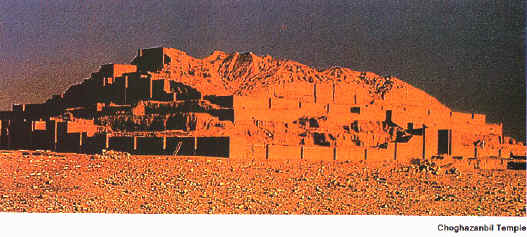
Choghazanbil Temple
Glazed bricks in blue, white, yellow, and green with animal and floral ornaments, were developments of this period. Also, cold or hot climate buildings, used appropriate technical principles. Splendid halls, wide hallways and massive stone columns seen in these buildings, are elements of a particular architectural school of the period.
One of the magnificent monuments of Achaemenid architecture is Pasargard palace at Shiraz. Pasargad is the oldest imperial capital city of the world. Remnants of the palace show that it had been one of the most splendid buildings of the world, the splendor of which can be observed even now after 2,500 years. The architecture of Pasargad is the art which culminated in the construction of Persepolis.
Pasargad palace is situated about 600m from the tomb of Cyrus the Great. With the exception of single enduring structure, Pasargad is now largely in ruins, but one can see that how imposing it must have been in many respects.
Pasargad palace consists of a central hall, four vans on four sides of the hall, and two rooms on both sides of its southern ivan. The hall floor was paved with marble. The slender columns of the palace were ornamented and crowned by striking bull or lion capitals. Entrances are of polished black stone.
Concerning Pasargad, Professor A.U. Pope writes: The building system of Pasargad is constructed on an area which is 2.5 km in length. Palaces are constructed with cut stones and relieves. The buildings were constructed in 550 BC, during the reign of Cyrus the Great. Massive black and white stones and colossal human-headed winged bulls or winged angels are used to construct and decorate the palace. Plaster work is also used in the palace, with paintings on it. On both sides of the 78 main gates, high relief images of the king are seen.
Behind the king, servants are holding an umbrella above his head. For the first time in Iranian sculpture, dresses are elegantly embodied. Relieves of the king's dress are ornamented with gold.
Tomb of Cyrus the Great is situated in the south of Pasargad, in a rectangular chamber with walls of mud brick. The tomb is placed on top of a six-stage platform and surrounded by staircases. The whole building is of colossal cut limestone which is rather whitish, elegant and marble-like. The tomb ceiling is covered with five huge flat stones in the form of a peaked roof. Pasargad complex might be considered a complete manifestation of Persian architecture.
Persepolis is another architectural masterpiece of ancient Iran. This splendid and majestic building, the remains of which are scattered near Shiraz, Fars Province (south Iran), marvels its visitors.
Persepolis is constructed on a huge platform of 125,000m2, backed up against a rugged mountain. Its construction date goes back to about 516 BC The construction uses black limestones similar to marble, excavated and brought to the site from quarries in a distance of 40 km on the west of Persepolis.
Throughout the centuries, famous travelers, archaeologists and Iranologists who have visited the remnants of Persepolis, have described it with the most beautiful words. From their point of view, Persepolis is a symbol of Iranian architecture in the ancient period. The high relieves on its colossal columns, gates, and stairways of Iranian architecture.
Various artists from Media, Egypt and Libya had been employed to construct the numerous palaces of Persepolis. However, as Professor A.U. Pope puts it, what the Persian architects brought in from the outside was merged with and balanced in the Iranian art, giving rise to ensemble quite new and different from the art of those nations from which they might have been derived.
|
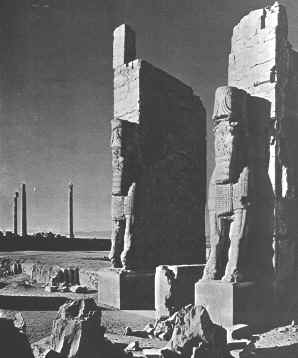 |
The greatest architectural and sculptural monuments of ancient Iran are remaining in Persepolis. In this massive building, the Achaemenid architects have managed to combine beauty and magnificence. Standing on its rock-cut podium, the great hall of Persepolis contained thirty-six columns (in six rows), 18.5m high. The walls were of mud brick and ornamented with painted and floral designs. Ivory, gold, and precious stones were among materials used in the mosaic works of the hall. Persepolis was not a political and administrative capital of the Achaemenids. It was a sacred national shrine, potent sensing for the spring festival, Now Ruz. The festival was celebrated on the first day of spring, among certain formalities.
Representative of nations subjected by the Achaemenid Empire would offer their gifts in this palace. Apadana palace is one of the most attractive palaces of Persepolis. Golden tablets unearthed from under the plinths of the palace columns give its date of construction in 6th century BC The tablets, now kept in Ancient Iran Museum, were discovered inside stone boxes. Their inscriptions in the languages of old Persian, Ela mite, and Babylonian, give remarkable accounts of how Persepolis was built. Palace of Xerxes, Palace of Darius 1, Gate of All Nations, Treasury, Hall of a Hundred Columns, and Throne Hall of Xerxes are among the most significant structures so far discovered in Persepolis. Stone columns are among the main architectural elements of Achaemenid period. Four types of capital have been used in Persepolis: bull-headed, lion-headed, horned lion (a legendary animal), and man's head.
The official arts of this ancient kingdom of Iran are completely embodied in Persepolis. Stone carving remained of Persepolis, too, are marvelous. Only in one stone carving more than a hundred soldiers known as "eternal guards" are seen in military gestures. In another stone carving, the courtiers and noblemen are attending Now Ruz ceremony, as well as representatives of various subjected nations and tribes from different parts of the empire offering their tributes and gifts to the court. Among these, representatives of 28 different nations and tribes can be distinguished from their dresses.
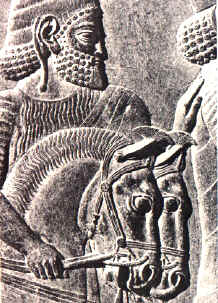
The stairways of Persepolis are another reflection of the majesty and splendor of Achaemenid architecture, cut out of huge stones. Each row consists of 111 steps. The steps are so low in height that one can ascend them mounted on a horse.
The Gate of All Nations in Persepolis is a gate through which the representatives of all Iranian nations and tribes used to arrive and proceed towards the Audience Hall Persepolis, the greatest architectural treasure of Iran, was destroyed and burned down by Alexander in 330 BC However, it remnants are the most valuable heritage of Persian architecture for other nations of the world.
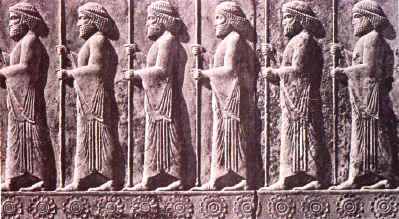
Susa Palace is another important architectural monument of Achaemenid period. A valuable inscription was discovered at Susa which gives a good account of its construction by Darius I. Ruins of this palace show how skillfully the stones were carved and ornamented for architectural purposes at that period.
After the fall of Achaemenid Empire, we are witness to a period of stagnation in the development of Parthian architecture, which resulted from a hundred years of domination by Alexander and his successors - Seleucids.
| Parthians managed to oust Seleucids
from the mainland Iran after successive fights against Macedonian forces, and establish
the Parthian dynasty (174 BC - 224 A.D.). Diakonov, a Soviet archaeologist, considered the
Parthian architecture to be under the influence of Greek art. However, the idea cannot be
applied to all aspects of Parthian architecture. An architectural form known as Ogee to
the European and zigzag molding to the Iranian architects, is of Parthian origin. Parthian architects used to construct palace walls with cut stones. They also used stucco to render the walls. The themes of their stuccos were geometrical lines and floral designs. In stone carving, attention was paid to the creation of equestrian statues in relief. |
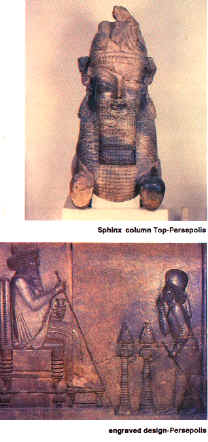 |
Some of the relieves created by great Parthian artists are remaining in Behistan (Bisotun) and Susa. Sasanians (224-642 BC) were from the Province of Pars, who revived the glories of Achaemenid Persia and created a national art. The Sasanian architectural style can be distinguished from the existing ruins of palaces, worship places, fortifications, bridges, and dams. Sasanians built big towns the remnants of which remind us of their remarkable achievement and breadth of mind. An outstanding feature of their architecture is the construction of high-rising brick vaults wider than any vault in the known world of the period. Taq-i-Kisra at Ctesiphon (present-day Iraq) with a great open vault which spans 75 feet, is 90 feet high and nearly 150 feet deep, and considered one of the most splendid palaces of Sasanian period. Artists used stone and strong gypsum as their construction materials and ornamented their creatures with unique stucco or mosaic works.
The Sasanian architecture went further beyond the borders of Iran and left its impacts on the arts of India, Turkmanistan, China, Syria, Asia Minor, Constantinople, the Balkans, Egypt and Spain.
Construction of huge gates and massive domes was a common practice in Sasanian architecture, which reappears in the mosques and palaces of Islamic period. Vaults of baked bricks, are among the innovations of Sasanian architects. Stone was not used as a constant construction material by these architects. However, they have shown their skill in making use other materials, particularly brick and gypsum. They took new steps in developing vaults and domes. Ctesiphon was the largest and most splendid Sasanian capital city, the ruins of which are already standing on the bank of Tigris River.

The greatest stone carving monument of Sasanian architecture is situated near Darab Gerd (Fars Province) and known as Naqsh-i-Rustam. This magnificent monument is an embodiment of the victory of Shapur I over the Roman Emperor Valerian (260 AD). Here, similar to Pasargad, there are two stone fireplaces which were used in fire worshipping ceremonies. The most remarkable stone carving at Naqsh-i-Rustam is seen on the upper front of the tomb of Darius the Great. The statue of Darius is carved as a 2.70m high profile looking right, in the most artistic way. Darius is standing on a three-step platform with a crenellated crown on his head. Besides, two Parsi military commanders are also carved on the tomb wall.
Bishapur was another town of Sasanian period built by Shapur I in Fars (Province), the remnants of which are existing at the site. The sculpture of the period can be sought for in Bishapur relieves, which reached its peak of development in that period. Some of the relieves are among the masterpieces of sculpture art. The Bishapur relieves are portrayals of the king's investiture by Ahura Mazda, his victories, his enthronement, his wars and huntings.
During Sasanian period, stucco art achieves a higher rank. All Sasanian palaces are decorated with stucco. The artists have mainly used geometric designs and floral patterns to complete their stucco ornaments.
Wall painting too, had been used during this period. Murals had existed in ancient Asia Minor. Outstanding indications of this art were found from the 4th millennium BC onward. Its beginning in Apadana, Susa, and Persepolis can be traced in the 2nd millennium BC.

Achaemenid art. It was widely used in Parthian period, and Sasanian artists proved to be loyal successors to Parthian art of painting. A remarkable example of this art is a hunting scene at Susa grated by Sasanian artists.
As put by the archaeologists, the early Sasanian kings used to carve their bias relieves on rocks near Persepolis, but their successors selected Taq-i-Bustan rock mean Kermanshah, west Iran, for this purpose.
Kermanshah was situated on the old Silk Road, at a site which was called "the Gate to Asia" by Professor Herzbeld.
The coronation scene of Ardashir II (279-383 A.D.) has been carved on two lateral fronts of the great cave of Taq-i-Bustan. The imperial hunting grounds are also portrayed in bias relief. A boat is floating ahead on a leaf. The king is standing on it and hunting the boards. Behind the king's boat, other boats are moving ahead, wherein are sitting the musicians while playing and signing. In another scene of this huge rock carving, the hunted animals are shown on the back of huge elephants.
The Sasanian artists were propagating the artistic achievements of many thousand years of Persian plateau from India through Pyrenees. Shami is another Iranian temple of the period situated on the left bank of Karun river, at the foot of Bakhtiari mountains, southwest Iran, wherein a number of valuable art works of Sasanians have been unearthed.
Sasanian art as used in architecture is not limited only to the construction of towns, palaces, and massive rock carvings. Sasanian artists were also great masters in constructing arch dams and bridges, (to be reviewed later). Several Iranologists have written a Jot about the splendor of Sasanian art and its impacts on other nations and artists.
However, the most concise remarks in this connection were made by the late A.U. Pope renowned Iranologist, as follows: "Sasanian art is the culminating phase of ancient east arts. As a message from a global Empire, it is the product of an eastern resurrection and bridges the gap between ancient Asiatic as well as modern Islamic and Medieval civilizations. Sasanian Iran, by transmitting its inherited traditions to the Islamic world, and by relying on its artistic heritage, newer civilizations.
Advent of Islam in Fran (635 A.D.) gave rise to great upheavals in architecture, and laid the foundations for Islamic architecture all over the world. To be sure, no Persian building from the first two Islamic centuries have survived, but from third center onward, Islamic building flourished rapidly and marvelously expanded during the next centuries.
|
|
A great surge of building works together with unique decorations and calligraphy appeared in these centuries. To learn more about the Islamic period refer to the next page.
